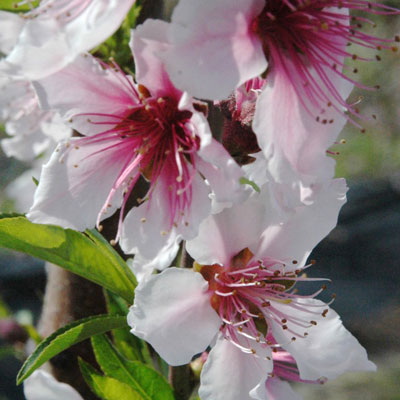Urgent Cold Warning!
Temperatures Saturday night, Sunday night and evening Monday and Tuesday nights are forecast to be below freezing across big swaths of Texas. In some cases, way below freezing. Low 20’s in counties just north and west of DFW. Single digits in the Panhandle. Did we turn the page back to January?

Peach crops can be ruined by late freezes. Keep reading. (Photo borrowed from Texas AgriLife Extension, by Kathleen Phillips)
You need to take action to protect your vulnerable plants. Let’s make a list.
• Potted plants need to be set into protected locations. Tender tropicals need to come back indoors. Cool-season annuals in pots need to go into an unheated garage. Nursery plants that you’ve bought but not yet planted probably need to go into that same unheated garage, especially if you’re expecting to see temperatures well below freezing. It really depends on the plant types.
• Flowering bulbs such as tulips and daffodils can either be cut to be enjoyed indoors, or you can try covering them with frost cloth. I’m writing this for the entire state, mind you. If it’s barely going to freeze where you are, they’ll be fine outdoors, especially if covered. But if you’re in the far reaches of the Panhandle, and if they’re blooming already (probably aren’t, but just in case), cutting may be the better option. If you do try to cover them, erect some kind of stakes to keep the frost cloth from pressing down on the flowers and stems.
• Cool-season annuals such as pansies and pinks can handle a good bit of cold, so unless it’s going to drop below 25, you can leave them uncovered. However, for critical commercial plantings and in areas where it’s going to get even colder, also for beds that have other, less-hardy types, covering is a good plan. Use lightweight frost cloth. Cover the beds border-to-border, securing the cloth to the ground with bricks or other weights. Frost cloth gains you 6 or 8 degrees of protection.
• Flowering shrubs and smaller flowering vines can also be covered with frost cloth secured in place over the plants.
• Larger trees, including peaches and other flowering fruit trees are far more challenging. Home gardeners hear about orchard managers using mist sprinklers to protect against freezing temperatures, but they have specialized equipment. The old warning “Do not try this at home” really applies here, because with home landscape sprinklers, we end up putting too much water onto the branches and the weight of the ice causes our trees to break. It’s better to accept our loss of one year’s fruit crop than to ruin our trees forever.
I searched online to find what university horticulturists offered as guidelines for protecting fruit trees from late freezes. This, written by Charlotte Glen of North Carolina State Extension, seemed to sum it up best:
Fruit Trees
For most fruit trees, open blossoms and the phase just after petal shed are the most sensitive to frost or freeze damage. During this time, temperatures of 28 degrees are expected to kill 10 percent of blossoms.
Losing 10 percent of their potential fruit load could actually be helpful to many fruit trees, which tend to set many more fruits than they can support.
The danger comes when temperatures fall any lower – a dip down to 25 degrees could kill up to 90 percent of blossoms and severely limit this year’s crop.
From a practical standpoint, there is little that can be done to protect fruit tree blossoms. Small trees could be covered with row cover or plastic but covers will need to completely envelop plants and extend fully down to the ground to provide protection.
